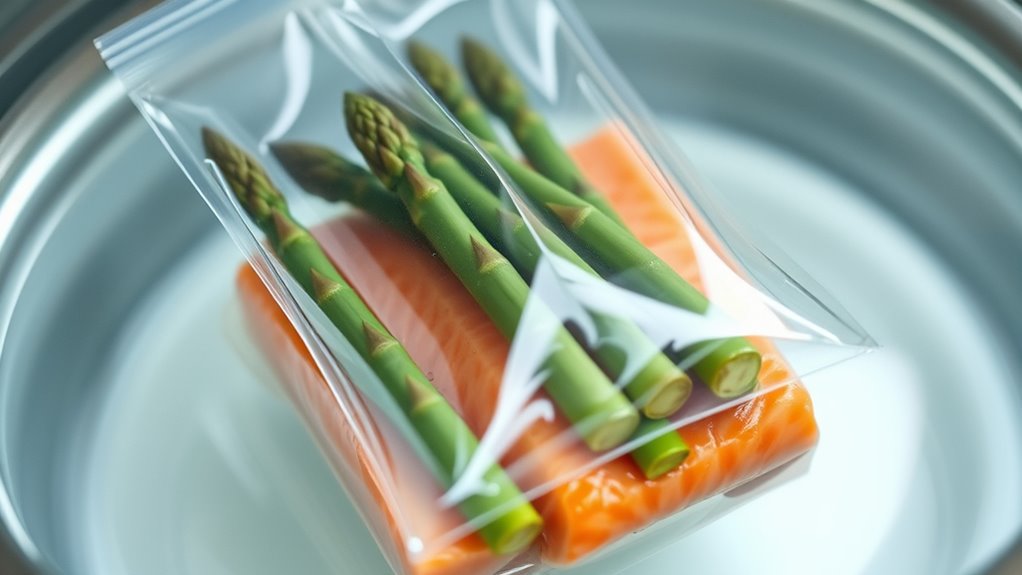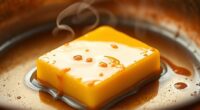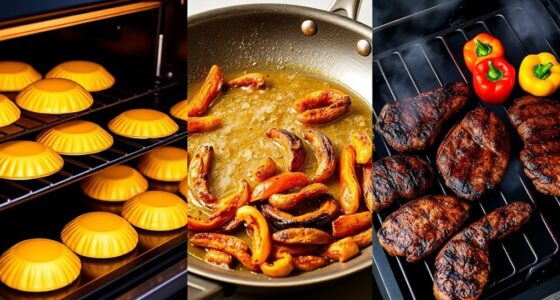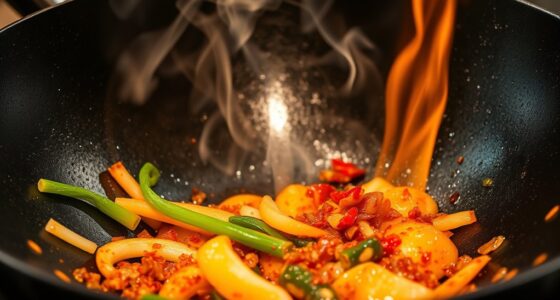Sous-vide cooking prevents nutrient loss by maintaining precise, gentle temperatures that avoid overcooking and vitamin degradation. Sealing food in vacuum bags minimizes nutrient leaching into cooking liquids and locks in water-soluble vitamins like C and B. This controlled environment helps preserve delicate nutrients and prevents the high heat that destroys them in traditional methods. If you want to discover more about how this method safeguards nutrients, keep exploring the science behind sous-vide.
Key Takeaways
- Precise temperature control prevents excessive heat that causes nutrient degradation, preserving sensitive vitamins like C and B vitamins.
- Vacuum-sealed bags retain water-soluble vitamins by preventing leaching into cooking liquids.
- Gentle, low-temperature cooking minimizes nutrient loss compared to traditional high-heat methods like boiling or roasting.
- Consistent low temperatures reduce nutrient breakdown, maintaining nutrients within the food rather than in discarded cooking water.
- Reduced need for added fats and oils prevents nutrient damage caused by high-temperature cooking fats.

Sous-vide cooking is often praised for its precision and ability to retain moisture, but many wonder how it affects the nutritional quality of your food. The good news is that this cooking method can actually help preserve nutrients better than traditional techniques. One of the key reasons is the exceptional temperature control it offers. Unlike conventional cooking, where heat can fluctuate and cause overcooking or nutrient breakdown, sous-vide maintains a consistent, low temperature throughout the process. This gentle heat prevents the destruction of sensitive vitamins, such as vitamin C and B vitamins, which are prone to degradation at higher temperatures. By keeping the temperature steady and controlled, you’re able to retain more of these essential nutrients in your food.
The precise temperature control also means that you cook your ingredients just enough to reach perfect doneness without going beyond. Overcooking often leads to nutrient loss, especially for water-soluble vitamins that leach out into cooking water or degrade with heat. With sous-vide, since you’re cooking at a precisely set temperature, there’s less risk of losing these nutrients. For instance, vegetables cooked sous-vide at lower temperatures can retain their vitamin content better than boiling or roasting. Similarly, proteins like fish and chicken stay tender and moist because they aren’t subjected to high heat that can denature nutrients or cause them to break down.
Another benefit of this method is that the sealed vacuum bags prevent nutrient leaching into cooking water, which is a common issue in boiling or steaming. When you cook with traditional methods, nutrients can escape into the water and be discarded unless you consume the cooking liquid. Sous-vide avoids this problem entirely, locking in nutrients within the food itself. This means you get more nutritional value per serving, whether it’s a tender steak or a delicate piece of fish.
Furthermore, because sous-vide cooking is so controlled and gentle, it reduces the need for added fats or oils, which are often used to compensate for overcooking or dry results. This not only helps you maintain a healthier diet but also ensures that the nutrients in the food aren’t compromised by excessive fats or high-temperature cooking methods. Additionally, the consistent temperature helps prevent nutrient degradation, ensuring your meals are both delicious and nutritious. Overall, by offering consistent temperature control, sous-vide optimizes nutrient retention, making your meals both delicious and nutritious.
Frequently Asked Questions
How Does Temperature Control in Sous-Vide Affect Nutrient Preservation?
You see, temperature control in sous-vide is vital because it guarantees temperature stability, preventing fluctuations that can degrade nutrients. The precise heat transfer keeps food at a consistent, ideal temperature, which minimizes nutrient loss. By maintaining steady heat, you preserve vitamins and minerals better than traditional methods. This careful control allows your food to cook gently, locking in nutrients and flavors while avoiding overcooking.
Are Certain Nutrients More Protected by Sous-Vide Than Others?
You’ll find that sous-vide cooking better preserves certain nutrients, especially those sensitive to heat and oxygen. Because it maintains precise temperatures, it safeguards nutrients with high bioavailability factors, like vitamins B and C, and enhances nutrient bioaccessibility by gently breaking down food fibers. This gentle process helps retain water-soluble nutrients and antioxidants, making your food more nutritious compared to traditional cooking methods.
Can Sous-Vide Cooking Extend the Shelf Life of Nutrient-Rich Foods?
Imagine sealing treasures in a vault—sous-vide creates a similar environment for your foods, locking in freshness and nutrients. By maintaining precise temperatures, it enhances food safety and slows spoilage, effectively extending storage longevity. While it doesn’t magically preserve foods forever, sous-vide helps keep nutrient-rich items safer and fresher longer, allowing you to enjoy their benefits even days after cooking. It’s a smart way to maximize your food’s lifespan.
Does Vacuum Sealing Impact Nutrient Retention During Sous-Vide?
Vacuum sealing plays a key role in nutrient retention during sous-vide cooking. By removing air, it minimizes oxidation and prevents nutrient degradation caused by exposure to oxygen and light. This process helps preserve vitamins and minerals, ensuring your food retains its nutritional value. So, when you vacuum seal before sous-vide, you’re effectively protecting nutrients and maximizing the health benefits of your cooked meals.
How Does Cooking Time Influence Nutrient Loss in Sous-Vide?
Cooking duration directly impacts nutrient degradation in sous-vide. If you extend the cooking time, you risk losing more nutrients, especially water-soluble vitamins like C and B. Shorter cooking times help preserve these nutrients while still tenderizing your food. By carefully managing your cooking duration, you can minimize nutrient loss, ensuring your meal retains maximum flavor and nutritional value without overcooking.
Conclusion
By cooking sous-vide, you fundamentally lock in nutrients through precise, low-temperature methods, preventing the leaching and degradation common in traditional methods. Think of it like sealing your food in a protective barrier—keeping vitamins and minerals intact. This science-backed approach shows that sous-vide preserves more nutrients, so your meals stay healthier and more flavorful. If you want to maximize nutrient retention, embracing sous-vide is a smart choice—it’s like giving your food a protective shield.










